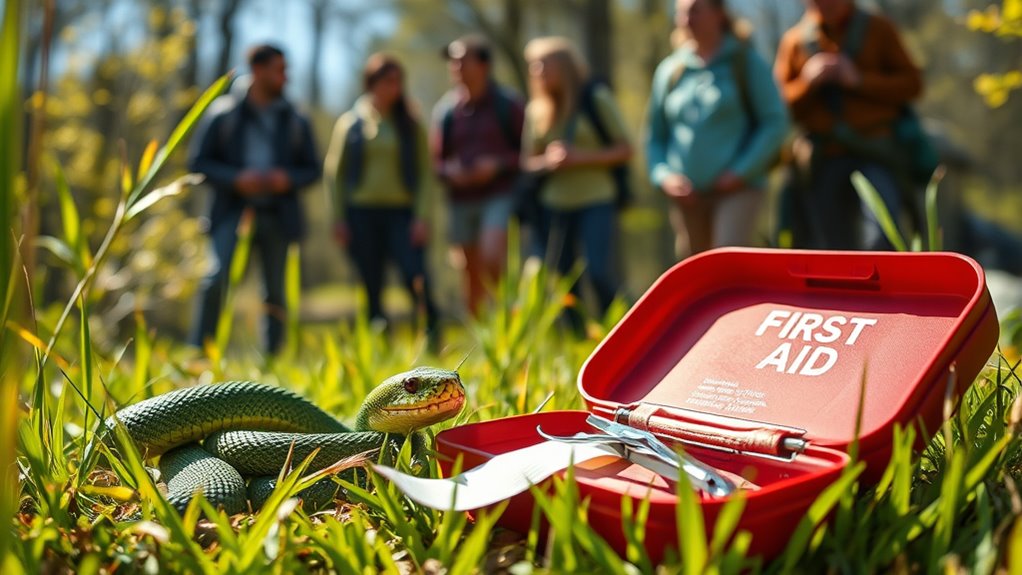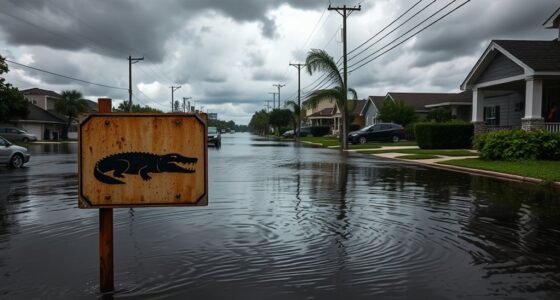As temperatures rise, snakebite cases increase considerably. For every degree Celsius the temperature goes up, snakebites spike by about 6%. Spring and summer see the highest numbers, with outdoor activities like hiking prompting more human-snake interactions. In areas like Georgia, the risk is particularly high. By staying aware of your surroundings and taking precautions, you can reduce your chances of encountering snakes. Discover more about the seasonal trends and safety measures to keep in mind.
Key Takeaways
- Snakebite incidents rise by 6% for each degree Celsius increase in temperature, particularly during spring.
- Warmer weather encourages outdoor activities, leading to more human-snake interactions and higher bite risks.
- Summer experiences the highest overall snakebite numbers, despite spring showing a stronger correlation with temperature spikes.
- Georgia reports over 3,900 venomous snakebites from 2014 to 2020, highlighting the state’s significant risk.
- Climate change and extreme weather patterns like El Niño further elevate snake activity and bite risks.

As temperatures rise with the arrival of warmer weather, you’re more likely to encounter snakes, which greatly increases the chances of snakebites. Research shows that for every degree Celsius increase in temperature, snakebite incidents soar by about 6%. This trend is particularly pronounced in hotspots like Georgia, where outdoor activities ramp up as the weather warms, leading to more human-snake interactions.
With spring being the season most correlated to temperature spikes and snakebites, it’s vital to stay vigilant during these months. During warmer months, particularly in spring and summer, the risk of snake encounters heightens. While summer holds the record for the highest number of snakebites, the strongest link between rising temperatures and an uptick in incidents is observed in spring.
As you enjoy outdoor activities—hiking, gardening, or simply spending time in nature—you’re inadvertently increasing your chances of crossing paths with these reptiles. Climate change is a significant player in this equation, as rising global temperatures are linked to heightened snake activity.
Extreme weather conditions, like those seen during El Niño cycles, can further complicate this issue, causing variations in snake behavior and increasing the likelihood of bites. The data collected from emergency departments across regions helps paint a clearer picture of the patterns at play. Researchers analyze hospital visits related to snakebites in relation to weather conditions, affirming that daily temperature increases are statistically tied to a rise in venomous snakebites.
The health implications of this rising trend can’t be overlooked. Most snakebite hospitalizations involve venomous snakes, which can lead to severe consequences. In areas with limited healthcare access, the risks associated with snakebites escalate, posing a significant public health challenge.
As you venture outdoors in warmer weather, it’s important to be aware of your surroundings and the potential hazards that come with increased snake activity. In Georgia alone, over 3,900 venomous snakebites were reported between 2014 and 2020, highlighting the need for awareness and caution.
The overall snakebite numbers peak during summer, but the correlation between warmer temperatures and snakebites remains strong throughout spring. By understanding these trends and taking precautions, you can enjoy the great outdoors while minimizing your risk of encountering these potentially dangerous reptiles.
Stay informed, stay cautious, and enjoy the beauty of nature responsibly.
Frequently Asked Questions
What Should I Do if I Encounter a Snake?
If you encounter a snake, stay calm and give it space. Avoid approaching or trying to kill it. Instead, slowly back away and allow it to leave.
Use a walking stick to tap ahead of you, alerting the snake to your presence. If you need to move over logs or rocks, step on them rather than over them.
Remember to familiarize yourself with local snake species to aid medical teams if bitten.
How Can I Tell if a Snake Is Venomous?
To tell if a snake’s venomous, observe its head shape, body features, pupil shape, presence of pits, and fangs.
If it has a triangular head, thick body, vertical pupils, heat-detecting pits, and fangs, it’s likely venomous.
Remember, some non-venomous snakes can mimic these traits.
Stay alert, keep your distance, and don’t provoke it.
Knowing these signs can help you stay safe and enjoy nature without unnecessary fear.
Are Certain Areas More Prone to Snakebites?
Yes, certain areas are definitely more prone to snakebites.
Tropical and agricultural regions worldwide often see higher incidences, particularly in the southern United States. If you’re in rural areas, especially during weekends or warmer months, your risk increases.
Regions like South Asia, Africa, and South America also face significant threats. Staying aware of your surroundings in these high-risk areas can help you avoid dangerous encounters with snakes.
What Are the Symptoms of a Snakebite?
Imagine feeling a sharp, searing pain suddenly coursing through your leg.
You look down to find redness and swelling rapidly spreading. Nausea hits, and dizziness follows, making you question your next steps.
As you struggle to breathe, you realize this might be serious. Blurred vision and muscle weakness creep in, leaving you in a state of panic.
If you ever suspect a snakebite, don’t wait—seek medical help immediately.
Can Pets Be Affected by Snakebites Too?
Yes, pets can absolutely be affected by snakebites. Each year, around 150,000 dogs and cats in the U.S. suffer from bites by venomous snakes like rattlesnakes and copperheads.
If your pet gets bitten, you’ll notice symptoms such as severe pain and swelling, which require immediate veterinary care.
To keep your furry friend safe, it’s essential to be aware of the risks and take preventive measures, especially in high snake-density areas.
Conclusion
As the sun shines brighter and temperatures rise, the great outdoors beckons you to explore. But with every step into nature’s beauty, remember the hidden dangers that lurk beneath the leaves. While warmer weather invites adventure, it also brings an uptick in snakebite cases. So, as you relish the thrill of hiking and camping, keep your eyes peeled and stay vigilant. Embrace the joy of nature, but don’t forget to respect its wild inhabitants.










